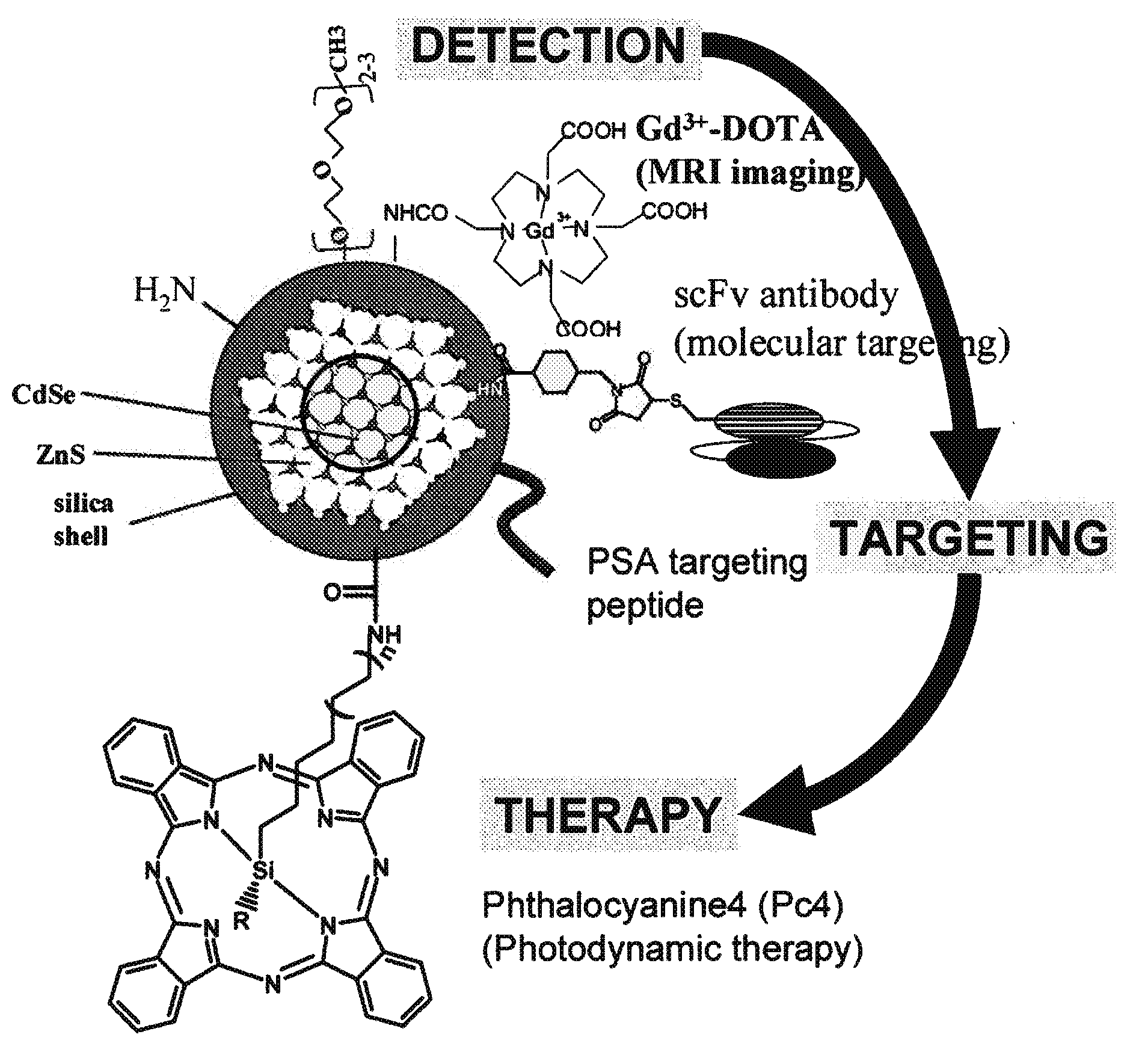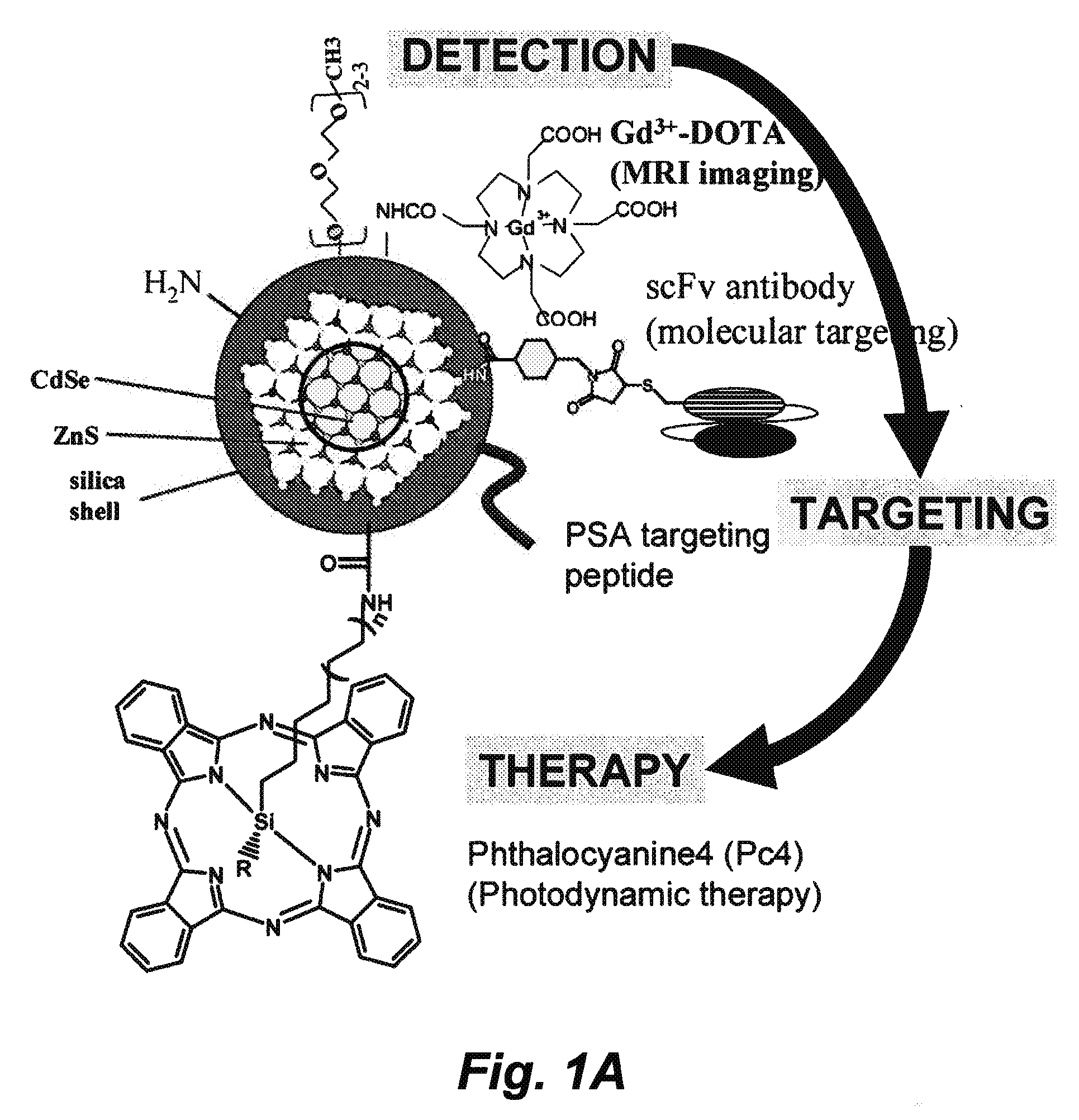Multimodal imaging probes for in vivo targeted and non-targeted imaging and therapeutics
a multi-modal imaging and probe technology, applied in the field of multi-modal imaging probes, can solve the problems of insufficient contrast obtained in mri, small intra-tissue differences, and inability to provide distinguishable relaxation times, so as to facilitate the addition of additional moieties and increase the stability and half-life of such molecules
- Summary
- Abstract
- Description
- Claims
- Application Information
AI Technical Summary
Benefits of technology
Problems solved by technology
Method used
Image
Examples
example 1
Paramagnetic Silica-Coated Nanocrystals as an Advanced MRI Contrast Agent
[0242]This example describes a robust and general method for embedding nanoparticles, such as quantum dots (QD) or colloidal gold (Au) nanocrystals, into a highly water-soluble thin silica shell doped with paramagnetic gadolinium (Gd3+) ions without negatively impacting the optical properties of the QD or Au nanoparticle cores. The ultrathin silica shell has been covalently linked to Gd3+ ions chelator, etraazacyclododecanetetraacetic acid (DOTA). The resulting complex has a diameter of 8 to 15 nm and is soluble in high ionic strength buffers at pH values ranging from approximately 4 to 11. For this system, nanoparticle concentrations exceed 50 μM, while most other nanoparticles might aggregate. In magnetic resonance imaging (MRI) experiments at clinical magnetic field strengths of 1.4 T (1H resonance frequency of 60 MHz), the gadolinium-DOTA (Gd-DOTA) attached to SiO2-coated QDs has a spin-lattice (T1) particl...
example 2
Multimodal Probes
[0294]A nanoparticle is constructed as illustrated in FIG. 1A. DOTA, anti-PSA / PSMA antibody, and Pc4 are conjugated to the amine group, the thiol group, and the carboxyl group on the Qdot, respectively. The resulting nanocomposite has modalities of MRI, PET, NIR imaging, antibody-based targeting, and photodynamics therapeutics. This nanoconstruct offers sensitive and molecular targeted imaging and imaging-guided intervention. Other modifications include, but are not limited to the conjugation of an enhancer to the photodynamic chemicals, scFv antibodies targeting other prostate cancer antigens identified in the SPORE, and specific peptides / inhibitors against prostate cancer surface antigens.
[0295]Construction of the Gd and 64Cu-charged DOTA-Qdot (amine group). We have constructed silica-coated Qdots with different surface groups, such as amine, thiol, and carboxyll groups, and can tune the wavelength of Qdot to the absorption window of Pc4. Using EDC-NHS chemistry, ...
example 3
Targeting Breast And Prostate Cancer In Vivo With Multimodal Probes
[0298]The multimodal nanoparticle probe described in Example 2 is used to target cancer in vivo. To target prostate tumors, it is possible to utilize two scFvs. One scFv stains primary and metastatic tissue and binds to MEMD (CD166). MEMD has recently been found to be overexpressed in up to 84% of prostate cancer. The second scFv can e A33 which binds an unknown prostate tumor antigen. A33 has exquisite specificity for metastatic prostate tissue
[0299]Although there is still some controversy about prostate cancer screening in asymptomatic men, several organizations have formally made recommendations for serum Prostate Specific Antigen (PSA) testing. PSA screening appears to reduce the number of prostate cancers detected at late stage, and the incidence of metastatic prostate cancer. However, because PSA-screening does not distinguish between benign and malignant prostatic disease, a large fraction of biopsies that are...
PUM
| Property | Measurement | Unit |
|---|---|---|
| diameter | aaaaa | aaaaa |
| diameter | aaaaa | aaaaa |
| diameter | aaaaa | aaaaa |
Abstract
Description
Claims
Application Information
 Login to View More
Login to View More - R&D
- Intellectual Property
- Life Sciences
- Materials
- Tech Scout
- Unparalleled Data Quality
- Higher Quality Content
- 60% Fewer Hallucinations
Browse by: Latest US Patents, China's latest patents, Technical Efficacy Thesaurus, Application Domain, Technology Topic, Popular Technical Reports.
© 2025 PatSnap. All rights reserved.Legal|Privacy policy|Modern Slavery Act Transparency Statement|Sitemap|About US| Contact US: help@patsnap.com



